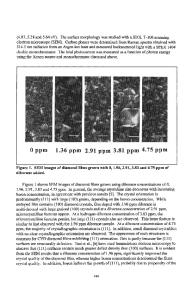In situ boron doping of chemical-vapor-deposited diamond films
- PDF / 1,529,734 Bytes
- 10 Pages / 612 x 792 pts (letter) Page_size
- 20 Downloads / 385 Views
MATERIALS RESEARCH
Welcome
Comments
Help
In situ boron doping of chemical-vapor-deposited diamond films X. Jiang,a) P. Willich, M. Paul, and C-P. Klages Fraunhofer-Institut fu¨r Schicht- und Oberfla¨chentechnik (FhG-IST), Bienroder Weg 54E, D-38108 Braunschweig, Germany (Received 2 February 1999; accepted 26 April 1999)
A systematic investigation of the boron doping of microwave-plasma-deposited diamond films was performed. Doping with levels up to 550 ppm was carried out in situ on undoped diamond film substrates in a microwave-plasma-assisted chemical vapor deposition with liquid trimethyl-, triethyl-, and tripropylborate and gaseous trimethylborane as doping sources. The dependence of the boron incorporation probability on the doping sources and on the process parameters was studied with secondary ion mass spectrometry. The doping-induced variations of phase quality and morphologic characteristics of the boron-doped diamond layers were investigated by means of scanning electron microscopy and Ramon spectroscopy. The incorporation of other impurities (i.e., hydrogen, nitrogen, oxygen, and silicon) were also determined by secondary ion mass spectrometry. The relations of the concentration of these impurities to the boron incorporation were also studied.
I. INTRODUCTION
To realize the attractive and manifold mechanical, electrical, and electronic applications the chemical-vapordeposited (CVD) diamond films have been doped in the past years by the use of different doping sources and doping methods.1–3 In general the investigations showed that the CVD diamond films can be doped in situ in p-type with boron in a large range of doping levels and that the morphologic characteristics of the doped films can be maintained if the doping level does not exceed a level of 6300 ppm. For boron concentrations greater than 1300 ppm some degradation in crystal quality was revealed by Raman measurement.3 Hall investigations showed much lower hole mobility of the doped films than is desired. This may be ascribed to the high defect density of the grown diamond crystals because an improved carrier mobility has been measured from the heteroepitaxially grown diamond films.4 On the other hand, a recent publication on the basis of homoepitaxial films indicates the importance of the doping quality for the electrical properties.5 The most used source for the in situ doping of CVD diamond films was diborane, which is very toxic. Doping with a nontoxic doping source consisting of trimethylborate introduced to C2H2–O2–H2 and CH4–CO2 gas systems was also investigated.6–7 It was shown that diamond films can be doped with such sources, and the
a)
e-mail: [email protected] J. Mater. Res., Vol. 14, No. 8, Aug 1999
http://journals.cambridge.org
Downloaded: 17 Mar 2015
morphologic characteristics of the film can be varied because of the doping. The distribution of boron through the film (depth profile) was, however, found not uniform, and a precise control of the doping level was often a crucial point of the doping. The poor control of the
Data Loading...










